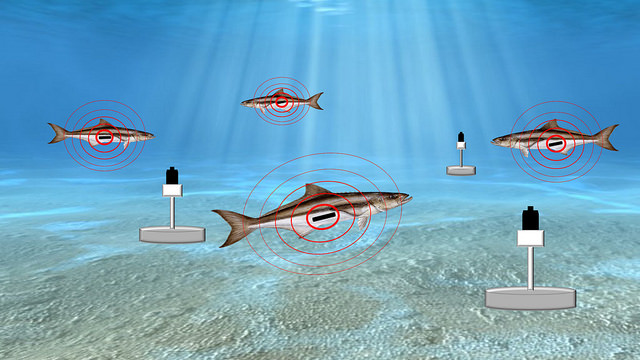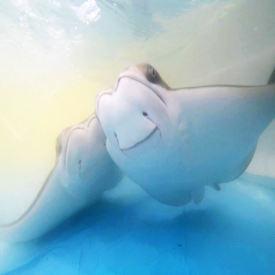HOME | satellite telemetry | acoustic telemetry | geolocators | radio telemetry | motus wildlife tracking system
individual marking | molecular markers | stable isotopes | movement models | future methods

How acoustic telemetry works. Florida Fish and Wildlife Conservation Commission, CC/Flickr.
Acoustic telemetry is most frequently used to track aquatic animals, and originated in the cloak and dagger days of submarine World War I warfare. Based on the principles of sonar, the first acoustic telemetry system for studying fish movements was developed in 1956 by the U.S. Bureau of Commericial Fisheries and the Minneapolis-Honeywell Regulator Corporation. Since then, there are now global networks of underwater receivers to track organisms as disparate as octopus and sharks.
Tracking animals in salt water requires specific solutions. Salt water absorbs radio waves, making them them a poor choice for sending messages in the ocean. In contrast, sound waves can travel more than 4 times faster in water than in air, making them an efficient choice tracking animals in the ocean.
Acoustic tracking systems consist of two primary components (transmitter and receiver), which work together to provide information about moving animals. The transmitters are electronic tags that emit a series of sound pulses into the surroundings. They can be surgically implanted or attached externally to an organism. The range of signal reception can vary from a few meters to more than a thousand meters. The signal typically transmits once every minute or two, in order to conserve battery life.
Receivers are small, data-logging computers that “listen” for tagged individuals. When a signal is identified, the tag’s unique ID code is saved with the date and time. The data from any single receiver provides a record of each signal to that location by a tagged individual. Researchers might deploy many receivers over large regions to understand the movement patterns of tagged individuals.
References
- Heupel, M. R., Semmens, and A. J. Hobday. 2006. Automated acoustic tracking of aquatic animals: scales, design and deployment of listening station arrays. Marine and Freshwater Research 57:1–13.
- Hussey, N. E., Kessel, S. T., Aarestrup, K. et al. Aquatic animal telemetry: A panoramic window into the underwater world. Science. 348 (6240)


Above: Cownose ray, Courtesy: Smithsonian Environmental Research Center. Left: Cownose Ray Migration from Chesapeake Bay down the Atlantic coast of the United States. Orange dots represent ray locations picked up by underwater acoustic receivers. Above: Cownose Ray, Courtesy Smithsonian Environmental Research Center

